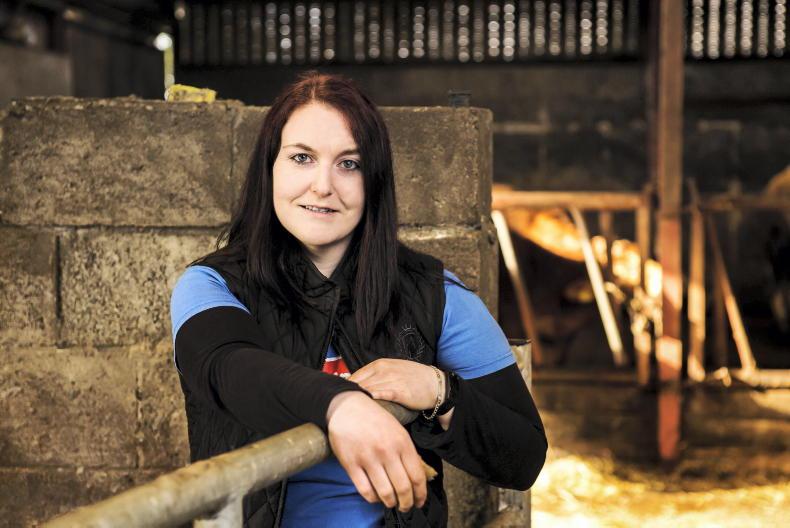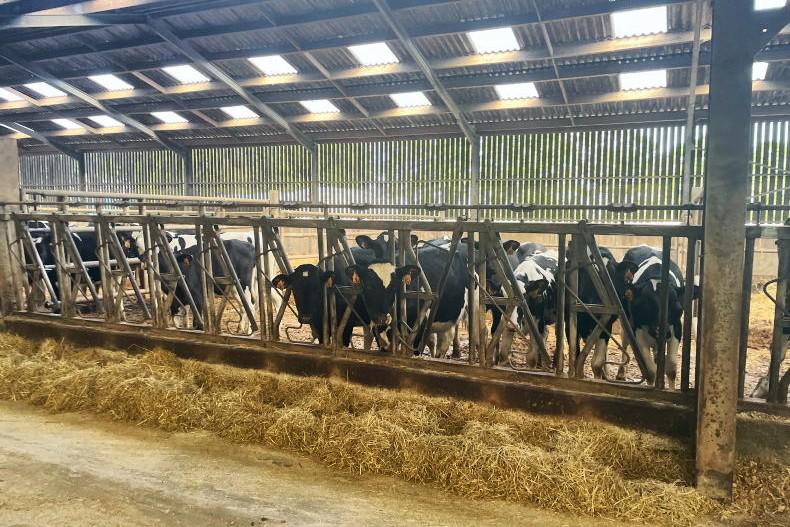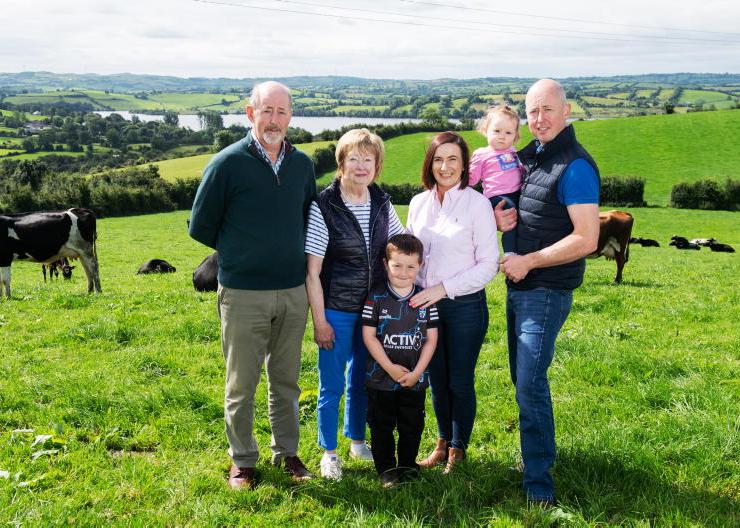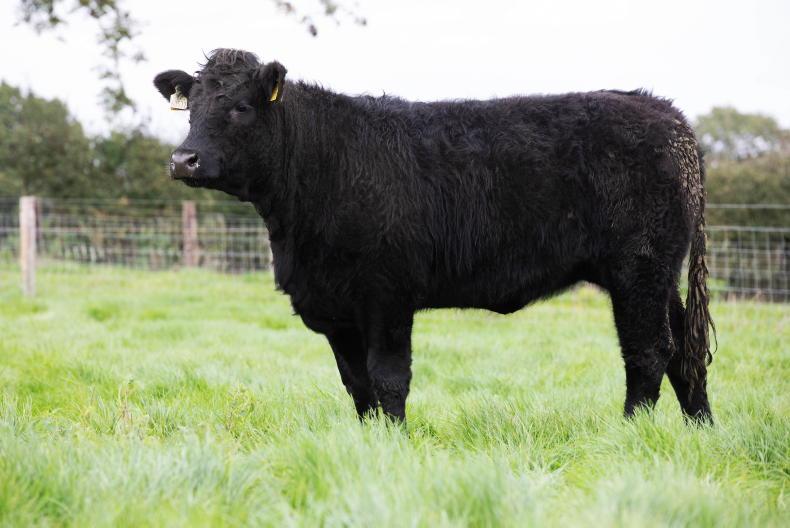Peter and
Simon Byrne
Castledermot, Co Kildare
Father-and-son combination, Peter and Simon Byrne from Castledermot in Co Kildare are showing the way when it comes to dairy beef production. Peter purchased the 138ac farm in 1988, where he grew crops and kept suckler cows up to 10 years ago. The Byrnes then got out of sucklers and into dairy calf-to-beef, with the enterprise going from 100 calves reared per year five years ago, to 160 calves reared per year now. In the intervening years, the Byrnes attended a local farmers market with their produce, but now just concentrate on the beef system.

Peter and Simon Byrne, Castledermot, Co. Kildare.
Peter says that they buy the calves at around three weeks of age and generally speaking they are a 50:50 mix of Holstein Friesian and beef breeds, and about 70% bullocks.
“We generally deal with six or seven dairy farmers, but mainly we buy off two farmers and finish everything here ourselves. We are looking more now on the CBV [commercial beef value], in order to pick calves with good beef traits,” Peter says.
Over the last three years the farm has averaged over 12.3t DM/ha of grass growth from 107kg N/ha. The Byrnes are big into clover and have both red and white types on the farm.

Grass and clover swards on the Byrne farm.
Red clover is included in the grazing seed mixtures at reseeding, with Peter saying that it gives an early boost, even if it doesn’t last.
Reseeding is a big part of the system and the judges were impressed by the quality of the grass offered to the stock. At peak, the farm is stocked at three livestock units per hectare, so grass demand is high, particularly in the autumn when the calves are bigger and before the cattle are slaughtered.
Animals tend to stay no more than two days in any paddock before being moved on. Heifers are finished off grass at 19 months of age, while the Friesian bullocks aim to be finished at 22 to 24 months.
Ken Gill
Edenderry, Co Offaly
Offaly farmer Ken Gill is paving the way when it comes to profitable, organic farming systems. Ken’s mantra is to be “as profitable as he can be, while doing as little [damage] to the environment as possible”. Farming a total of 90ha in one block, Ken is calving down 65 cows in the autumn in an eight-week window, with 100% AI and all progeny are finished as beef.

Store cattle on the Gill farm grazing high clover swards last autumn.
Ken is farming organically for the last 10 years and uses a crop rotation consisting of the following:
1. Grass fields are ploughed at the end of July and a four-way mix of turnip, rape, kale and vetch is sown. This is grazed by store cattle from 1 November for a six-week period. They are given a grass lie-back and a round bale of silage, with the fence moved every second day. 2. Oats and half-rate grass and clover are sown in the spring. After harvesting the oats, the grass and clover come up and this is grazed by cattle during the winter. 3. After two years of oats, a red clover, pea and wheat mix, or red clover pea and barley mix, is sown and this is cut for silage – with the subsequent cuts primarily of red clover. One of the big changes made on the farm over the last few years has been the introduction of a paddock grazing system, which Ken says has transformed the farm. The farm is soil-sampled every three years and most of the farm is at index three and four for phosphorus and potash. The only nutrients coming on to the farm are the 350 round bales of straw for bedding and about 60t of organic chicken litter.
Ken says that slurry and farmyard manure is a scarce commodity on the farm, so he has to be careful where he puts it. One of the lessons he has learned since going into organics is to never cut the same ground for silage twice in the one year and never cut the same field two years in a row. Over the last three years the farm has grown an average of 7.5t DM/ha.
Eamon and
Donnchadh McCarthy
Carrigeen, Youghal, Co Cork
Father-and-son duo Eamon and Donnchadh McCarthy are suckler beef farmers, farming 120 adjusted acres near Youghal in Co Cork. Running a split-calving, 55-cow suckler herd and rearing all progeny to beef, the McCarthys are big into their breeding and grassland management.

Eamon McCarthy, Youghal, Co. Cork is a finalist in the Sustainable Grassland Farmer of the Year awards.
Donnchadh works locally as an AI technician and the pair practice what they preach, with 100% AI used on their own cows.
Heat detection is carried out by automated heat detection aids, which has proved very useful as both men work off-farm.
Specialist bull beef producers, the McCarthys target 400kg carcase weights in the bulls at 16 months and about 320kg to 330kg carcase weight in the heifers at 18 months slaughter age. Docility, ease of calving and carcase weight are the key criteria used when picking bulls. Each bull gets about 1.25t of meal per head.

Jonathan Flynn, DAFM; John Maher, Teagasc; Ken Gill; John Farrell, AIB and John O'Loughlin from Grassland Agro at the Gill farm near Edenderry in Co. Offaly.
Over the last three years the farm has grown 11.8t DM/ha of grass and the majority of the land is in paddocks, with the McCarthys aiming to get between 1.5 and two days in each paddock.
Last year they spread 152kg N/ha, but their plan in the future is to do more reseeding and incorporate more clover – in order to grow more grass with less chemical nitrogen.
Eamon says that the first thing they look at after doing a grass cover is to check where the stock are going to next, what the cover is like and if it needs to be skipped over for silage. He says any paddock over a cover of 1,600kg DM/ha is generally baled.
Peter and
Simon Byrne
Castledermot, Co Kildare
Father-and-son combination, Peter and Simon Byrne from Castledermot in Co Kildare are showing the way when it comes to dairy beef production. Peter purchased the 138ac farm in 1988, where he grew crops and kept suckler cows up to 10 years ago. The Byrnes then got out of sucklers and into dairy calf-to-beef, with the enterprise going from 100 calves reared per year five years ago, to 160 calves reared per year now. In the intervening years, the Byrnes attended a local farmers market with their produce, but now just concentrate on the beef system.

Peter and Simon Byrne, Castledermot, Co. Kildare.
Peter says that they buy the calves at around three weeks of age and generally speaking they are a 50:50 mix of Holstein Friesian and beef breeds, and about 70% bullocks.
“We generally deal with six or seven dairy farmers, but mainly we buy off two farmers and finish everything here ourselves. We are looking more now on the CBV [commercial beef value], in order to pick calves with good beef traits,” Peter says.
Over the last three years the farm has averaged over 12.3t DM/ha of grass growth from 107kg N/ha. The Byrnes are big into clover and have both red and white types on the farm.

Grass and clover swards on the Byrne farm.
Red clover is included in the grazing seed mixtures at reseeding, with Peter saying that it gives an early boost, even if it doesn’t last.
Reseeding is a big part of the system and the judges were impressed by the quality of the grass offered to the stock. At peak, the farm is stocked at three livestock units per hectare, so grass demand is high, particularly in the autumn when the calves are bigger and before the cattle are slaughtered.
Animals tend to stay no more than two days in any paddock before being moved on. Heifers are finished off grass at 19 months of age, while the Friesian bullocks aim to be finished at 22 to 24 months.
Ken Gill
Edenderry, Co Offaly
Offaly farmer Ken Gill is paving the way when it comes to profitable, organic farming systems. Ken’s mantra is to be “as profitable as he can be, while doing as little [damage] to the environment as possible”. Farming a total of 90ha in one block, Ken is calving down 65 cows in the autumn in an eight-week window, with 100% AI and all progeny are finished as beef.

Store cattle on the Gill farm grazing high clover swards last autumn.
Ken is farming organically for the last 10 years and uses a crop rotation consisting of the following:
1. Grass fields are ploughed at the end of July and a four-way mix of turnip, rape, kale and vetch is sown. This is grazed by store cattle from 1 November for a six-week period. They are given a grass lie-back and a round bale of silage, with the fence moved every second day. 2. Oats and half-rate grass and clover are sown in the spring. After harvesting the oats, the grass and clover come up and this is grazed by cattle during the winter. 3. After two years of oats, a red clover, pea and wheat mix, or red clover pea and barley mix, is sown and this is cut for silage – with the subsequent cuts primarily of red clover. One of the big changes made on the farm over the last few years has been the introduction of a paddock grazing system, which Ken says has transformed the farm. The farm is soil-sampled every three years and most of the farm is at index three and four for phosphorus and potash. The only nutrients coming on to the farm are the 350 round bales of straw for bedding and about 60t of organic chicken litter.
Ken says that slurry and farmyard manure is a scarce commodity on the farm, so he has to be careful where he puts it. One of the lessons he has learned since going into organics is to never cut the same ground for silage twice in the one year and never cut the same field two years in a row. Over the last three years the farm has grown an average of 7.5t DM/ha.
Eamon and
Donnchadh McCarthy
Carrigeen, Youghal, Co Cork
Father-and-son duo Eamon and Donnchadh McCarthy are suckler beef farmers, farming 120 adjusted acres near Youghal in Co Cork. Running a split-calving, 55-cow suckler herd and rearing all progeny to beef, the McCarthys are big into their breeding and grassland management.

Eamon McCarthy, Youghal, Co. Cork is a finalist in the Sustainable Grassland Farmer of the Year awards.
Donnchadh works locally as an AI technician and the pair practice what they preach, with 100% AI used on their own cows.
Heat detection is carried out by automated heat detection aids, which has proved very useful as both men work off-farm.
Specialist bull beef producers, the McCarthys target 400kg carcase weights in the bulls at 16 months and about 320kg to 330kg carcase weight in the heifers at 18 months slaughter age. Docility, ease of calving and carcase weight are the key criteria used when picking bulls. Each bull gets about 1.25t of meal per head.

Jonathan Flynn, DAFM; John Maher, Teagasc; Ken Gill; John Farrell, AIB and John O'Loughlin from Grassland Agro at the Gill farm near Edenderry in Co. Offaly.
Over the last three years the farm has grown 11.8t DM/ha of grass and the majority of the land is in paddocks, with the McCarthys aiming to get between 1.5 and two days in each paddock.
Last year they spread 152kg N/ha, but their plan in the future is to do more reseeding and incorporate more clover – in order to grow more grass with less chemical nitrogen.
Eamon says that the first thing they look at after doing a grass cover is to check where the stock are going to next, what the cover is like and if it needs to be skipped over for silage. He says any paddock over a cover of 1,600kg DM/ha is generally baled.






















SHARING OPTIONS